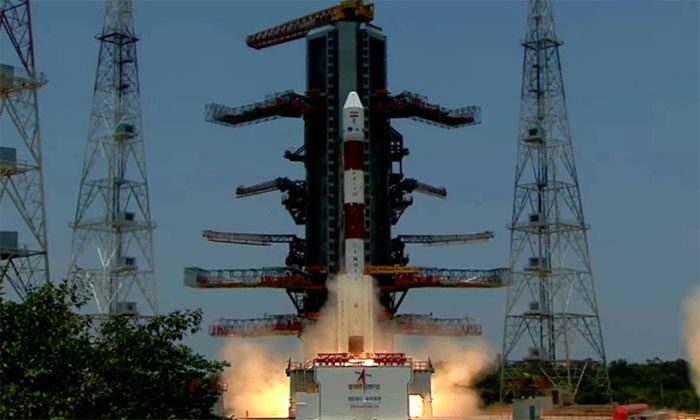The Indian Space Research Organisation (ISRO) successfully launched the solar probe Aditya-L1 from the Satish Dhawan Space Centre at 1:20 PM on September 2, according to Hanoi time.
This launch will place Aditya-L1 into a low Earth orbit. Following this, the probe will activate its propulsion system and head toward Lagrange Point 1 (L1), located between the Earth and the Sun. The name “Aditya” means “Sun” in Sanskrit. L1 is a gravitational equilibrium point that is 1.5 million kilometers away from the Earth. From this position, Aditya-L1 can study the Sun without interference from celestial obstruction phenomena.
India launches the Aditya-L1 probe. (Video: AFP)
The mission has multiple scientific objectives. Seven instruments on board Aditya-L1 are designed to observe the Sun’s atmosphere, surface (photosphere), magnetic field, and particles surrounding the star. One of the most intense areas that Aditya-L1 will study is the solar corona.
The solar observatory aims to uncover some mysteries about the star, including:
Exploring the Greatest Mystery of the Sun’s Temperature
Scientists studying the Sun pay particular attention to the corona, which is composed of plasma due to its extreme heat. The issue lies in the fact that the corona can heat up to 1.1 million degrees Celsius, according to NASA. In contrast, the photosphere, located 1,600 kilometers below the corona, has an average temperature of about 5,500 degrees Celsius, indicating that the Sun’s outer atmosphere is approximately 200 times hotter than its surface.
The vast majority of the Sun’s heat comes from nuclear fusion reactions occurring in its core. Therefore, temperatures will rise as one approaches the star’s core. While the Sun’s layers align with predictions, the corona does not, leading scientists to seek answers. Studying the corona from Earth is challenging because photons, light particles from the Sun’s surface, dominate the outer atmosphere. The best way to observe the corona from Earth is during a total solar eclipse when the Moon’s disk obscures the photosphere.
Aditya-L1 carries an instrument called the Visible Emission Line Coronagraph (VELC) designed to block radiation from the star. ISRO’s probe will also capture ultraviolet images of the corona and photosphere using the Solar Ultraviolet Imaging Telescope (SUIT). In addition to exploring the mysteries of the corona, the Aditya-L1 spacecraft will also observe solar flares and coronal mass ejections (CMEs), powerful explosions that can impact life on Earth.

Seven instruments of Aditya-L1 are designed to observe the Sun’s atmosphere.
Monitoring Solar Weather
CMEs are gigantic clouds of plasma that are ejected into space when the Sun’s magnetic field lines become twisted and snap back into alignment during a process called magnetic reconnection. This phenomenon always occurs in areas of strong solar activity, revealing the presence of sunspots. Sunspots can lead to the occurrence of solar flares, electromagnetic radiation bursts that often accompany CMEs but can also occur independently. Magnetic reconnection releases plasma at speeds of up to 11 million km/h, approximately 4,500 times the maximum speed of a fighter jet.
Aditya-L1 will investigate the mechanisms driving these phenomena, looking for processes in the corona and deeper layers of the Sun. Additionally, the spacecraft will observe such events after they move away from the Sun. CMEs directed towards Earth can reach the planet within 15 to 18 hours.
Aditya-L1 will study the changes in plasma during its journey from the Sun to Earth. The probe will also conduct various measurements of the plasma environment near Earth, using the Solar Wind Particle Experiment (ASPEX) and the Plasma Analyzer for Aditya (PAPA).
Charged particles ejected by CMEs targeting Earth will be deflected by the planet’s magnetic field. Subsequently, they collide with oxygen and nitrogen atoms in the Earth’s upper atmosphere, creating auroras. However, CMEs can also cause significant disruptions, such as strong geomagnetic storms that affect satellites, telecommunications, and electrical infrastructure on Earth. Therefore, understanding space weather and the plasma environment of Earth is crucial. Simultaneously, Aditya-L1 will also study the magnetic field around the planet using a high-resolution 3-axis digital magnetometer.
Other Research Objectives Regarding the Sun
Aditya-L1 will examine the solar magnetic field arches, which are gigantic plasma loops that occur when the high-altitude magnetic field lines extend beyond the photosphere and guide plasma through them. These arches can span thousands of kilometers, making the Sun appear like a massive tangled ball of yarn. The solar magnetic field arches appear to be closely linked to sunspots. Typically, the arches extend from one sunspot and terminate at another. Scientists are unclear about the three-dimensional structure of these solar magnetic field arches. Some recent studies suggest that they do not expand significantly at high altitudes.
Aditya-L1 will investigate the solar magnetic field arches and the plasma that composes them, measuring their temperature, velocity, and density. The spacecraft will also examine the magnetic dynamics of the Sun that guide these arches.


















































